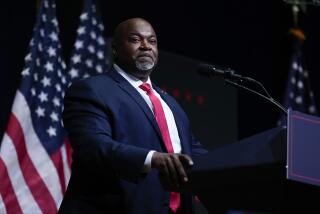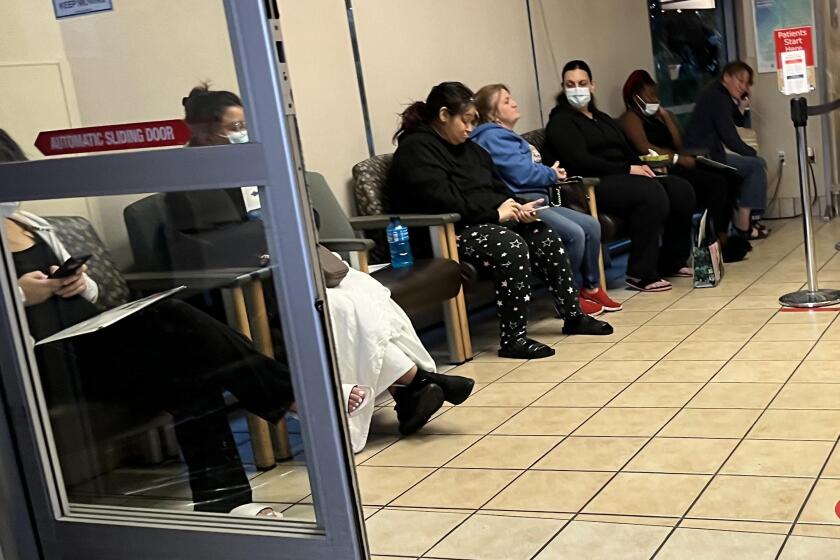Column: Patt Morrison asks: Voice of America director Amanda Bennett on government-funded media in age of Trump
Its name sounds like an artifact of the Cold War, but the Voice of America â the international news source funded by the U.S. government â has changed geography and technology. VOA just began a 24-hour Russian-language news channel on several platforms to reach Russian speakers throughout the old Soviet empire â a clear pushback against Russian government-run programming. Yet itâs home-front happenings that have put VOA in the news: first, the 2013 repeal of a law restricting the use of VOA-produced news inside the U.S., and then, toward the end of the Obama administration, a law that pulled the plug on a bipartisan board supervising the Broadcasting Board of Governors and replaced it with a CEO whoâs selected by the president and confirmed by the Senate. Thatâs sounded alarm bells for people who worry that President Trump might want to convert VOA into his own megaphone. John F. Lansing, whoâs the head of the Broadcasting Board of Governors, told NPR that it would be âillegalâ for the administration to tell VOA what to broadcast. And its director, journalist Amanda Bennett, details an operation that is government-funded, but, she says, not government-run.
CLICK HERE TO LISTEN TO THIS INTERVIEW ON THE âPATT MORRISON ASKSâ PODCAST Âť
The Voice of America is celebrating its 75th anniversary. How has its mission changed over the years?
During the period immediately after the Cold War, there was a kind of loss of faith in the mission, that the world was all OK and everything had happened the way it was supposed to. But really, its mission never did change, and you can see that right now, with the world being much more stressful, much more tense.
Our mission is exactly the same as it was back in the founding, and that is to bring objective news and information to countries that have no other access to it, and to tell Americaâs story overseas.
And so the geography of listeners has changed then?
Our very first broadcast was into Germany in the middle of World War II. Well, Germany is no longer a place where we broadcast into. The Voice of America broadcasts into large parts of Africa, into large parts of Asia, Indonesia, China, Cambodia, Vietnam, and large parts of Russia and the former Soviet republics.
The VOAâs mission came up in the news recently after a couple of Trump aides were sent to check out the VOA, and even though the Obama administration did essentially the same when it came in, it did raise some questions about whether President Trump would want to turn it into a President Trump channel.
That ignores the fact that the law, the broadcast law which has been in place, still remains in place â and wasnât the least bit affected by any of those things. And that really is where our firewall protection comes from: from this law that establishes us [as] an independent source of news and information â separate from the U.S. government, separate from influence from the U.S. government. Separate from any government, frankly. That has not changed.
Two VOA online postings created some controversy themselves. One was a tweet of the White Houseâs erroneous statement, posted without challenge, that the inauguration crowd was the largest for any inauguration ever. The other was a story about an ethics complaint against the Trump administration. You pulled the tweet, and took down the story until the VOA got a response from the White House.
Thatâs very interesting because the two instances you describe have actually opposite ideas. Both of them were completely routine decisions but one of them was taken as a pro-Trump move; one of them was taken as an anti-Trump move, and they both were were kind of normal, routine things.
One of them was during a live-tweeting session. The person who was live-tweeting it forgot to put quotation marks around [Press Secretary Sean] Spicerâs remarks, making it look like we were endorsing it. We caught that within the newsroom and corrected it almost immediately, but not before a bunch of people had tweeted out, Aha! Weâve caught you! Youâre now spreading the Trump administrationâs word! And of course it was just an honest mistake.
The other one is something that I feel very strongly and very passionately about. According to our charter, according to our history, and journalistic principles, we do fair and we do balanced and we do honest reporting and that means you donât do a story that has a single source. You donât do a story that doesnât show the opposite viewpoint. If youâre making a criticism of somebody, you allow the person or the institution youâre criticizing to make a comment. And this was a story that was critical of things having to do with President Trump, and it went out without having any comment there. So I said, go put some comment in â as Iâve been saying since 1975 in every story Iâve ever done.
The idea that somehow journalists would take this to be an example of some kind of bias is really kind of horrifying to me.
Over the years there has been criticism that itâs propaganda â itâs American propaganda but that itâs propaganda nonetheless.
Iâm always kind of curious as to why the same criticism isnât leveled at the BBC, which has exactly the same journalistic standards and missions that we do. So weâre doing exactly the same thing. We are legally separated from the government â that is actually in law â by something that we informally call the firewall. People take it very seriously on both sides of the equation, on the VOA side and on the rest of the government side.
Your audience is no longer only a radio audience but digital, too.
We broadcast â I use the word broadcast meaning just send out â in television, in radio, in digital, in various video means of transmission. Weâre working on mobile products. Essentially any way that somebody would get their news and information, thatâs the way we deliver it.
This year, weâve had the biggest audience growth in our history. Our audience went up by 50 million people and that brings us to 236 million people around the world, which is bigger than the audiences of three of the biggest cable providers in the United States by about a factor of 10.
Where was most of that growth?
The bulk of it was in Indonesia and Latin America, and it was for a couple of reasons. One is, in countries where weâre able to do that, we have an extremely robust series of partnerships with all the major networks in Indonesia, and we form a part of their newscasts. In Latin America, we have essentially evolved the model where the Voice of America is the Washington bureau for a very large number of Latin American stations.
Are you surprised by that? Because weâre in the age of Twitter and Facebook, of social media, where ideally anybody anywhere in the world can read anything they want from any source.
Remember that we are providing this news and information to people not just in English but in 47 different languages. So while a growing segment of the upper, educated population in virtually every country knows how to read and speak English, the vast majority of people in the places where we serve do not.
Since most broadcasts coming out of this country providing information on the United States are done in English, we are often the only source of that news that they have.
The Voice of America is part of the BBG [Broadcasting Board of Governors], as are Radio Free Europe and Radio Marti, broadcasting into Cuba. Are you in competition with elements within the BBG?
That was one of the reasons that we kind of lost our way back in the other years, is that they began to see themselves as being competition. We are now knit together into a cooperative body.
The VOA had been barred from its content being used inside the United States, and this changed in 2013. Why was that?
Well, the Voice of America had its roots in the 1940s, in World War II, and there was concern about propagandizing inside the United States. But there was also another motivation. In 1941 the domestic broadcasting industry was still in its early stages, so I think there was an understandable desire not to have a big government-funded competitor.
The reasons for the other change that allows us to broadcast in the United States was really aimed at the fact that we have a very large digital operation that we couldnât keep out of the United States, so if you said we canât be in the United States, you are sort of saying we canât be on the Internet. Itâs almost simply a recognition of the way the worldâs working.
How has your newsroom been reacting to this kind of scrutiny?
The best thing we can do for the American public and the world is to put our heads down and double down on doing the best journalism we possibly can. We need to be the most accurate, we need to be the most factual, we need to be the most balanced.
Weâve got a number of [journalist employees] whoâve been in prison for a long time, people whoâve undergone torture in order to do their work. These are people who are serious and passionate about a full and free press. A guy down the hall from me came here after his house was blown up because he is a journalist and he was writing stories that made someone angry.
I think that we need to think about that commitment to a free press and honor that commitment, and not trivialize that by saying that itâs going to be thrown away overnight. We feel like what weâre doing is exporting the 1st Amendment and the benefits of a free society overseas, and people are very serious about that.
If indeed part of the mission is to promote American values, promote democracy, would your story be indistinguishable from a story in, say, USA Today?
My feeling and I think everyoneâs feeling is by doing great journalism, we are promoting values, because thatâs at the core of some of our democratic values â the values of a free press. The only way it would be different from USA Today is that not everybody in every country knows exactly, for example, what a filibuster is, or knows what the electoral college is. So we spend a lot of time trying to think about how we can not only give them the news but contextualize it in ways that they can understand.
We just did a very nice digital explainer piece on how a Supreme Court justice is selected and confirmed. I went through it and honestly, I had not remembered two or three of the steps in there. It was very good for me to look at. I think a lot of people could benefit from that.
Follow the Opinion section on Twitter @latimesopinion or Facebook
More to Read
A cure for the common opinion
Get thought-provoking perspectives with our weekly newsletter.
You may occasionally receive promotional content from the Los Angeles Times.










